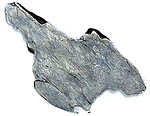 Exploring
Space, Page 6 of 6
Exploring
Space, Page 6 of 6
|
|

|
|

|
| Pallasite (stony iron meteorite) . Photo by Ron Hipschman. [ Click for a larger image.] |
Nickel-iron
meteorite.
Photo
by Ron Hipschman. [
Click
for a larger image.]
|
||

|

|
||
| Nickel-iron meteorite. Photo by Ron Hipschman. [ Click for a larger image.] |
Chondrite
(stony meteorite)
.
Photo by Ron Hipschman. [
Click
for a
larger image.]
|
||
|
|||
![]() hysicist
Peter Fiske and his colleagues at Lawrence Livermore Labs in northern
California are tracking down a meteorite impact in Southeast Asia, although
they haven't found the crater yet. What they have found is a profusion
of "tektites," glassy orbs created when soil melts from the
intense pressure of an impact. From the abundance, characteristics, and
location of these tektites, Fiske and his colleagues believe the impact
of a mile-wide asteroid that formed them occurred relatively recently,
about 770,000 years ago, the largest, most recent impact identified so
far.
hysicist
Peter Fiske and his colleagues at Lawrence Livermore Labs in northern
California are tracking down a meteorite impact in Southeast Asia, although
they haven't found the crater yet. What they have found is a profusion
of "tektites," glassy orbs created when soil melts from the
intense pressure of an impact. From the abundance, characteristics, and
location of these tektites, Fiske and his colleagues believe the impact
of a mile-wide asteroid that formed them occurred relatively recently,
about 770,000 years ago, the largest, most recent impact identified so
far.
Because meteorite impacts have occurred so infrequently in recent history, there aren't many clues for scientists to work with. "Meteorite impact is the least well-understood geological process we know of," Fiske says. "Impacts have the potential to cause massive damage to the earth and life on it. But we really don't understand the details." He hopes to get at those details: How much hot debris is ejected from a large impact? How much forest is ignited? Do medium-sized impacts (smaller than the dino-killer) cause regional but not global extinctions?
|
|
|
Sooner or later, history
will repeat itself and a globe-threatening impactor will target our planet.
There are programs in place to monitor the orbits of known asteroids and
comets, and more near-earth objects are being discovered by amateur astronomers
and the pros every year. In the best of circumstances, we could have decades,
perhaps a century, of advance warning. But what would we do if a big one
was on a collision course with earth? Doomsday movie scripts aside, scientists
haven't yet figured out how to prevent global catastrophe. Launching a
nuclear weapon could just break a meteoroid into pieces and spread out,
not prevent, the damage. If we're lucky, we'll have enough time to come
up with a solution.
![]()
|
About
Eleanor F. Helin:
Dr. Helin has been a
planetary scientist and astronomer for more than thirty years. She
is the Principal Investigator for the Near-Earth Asteroid Tracking
(NEAT) program, an author, and discoverer of 20 comets and asteroids.
To learn more about Dr. Helin, see her
biography
at the
Women in Science
and Technology
website. Also, visit the
NEAT
Program
website for extensive information on Dr. Helin's research.
|
|
|
|
|